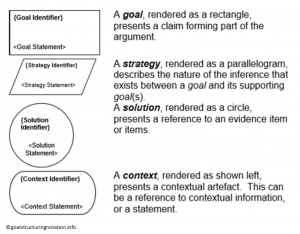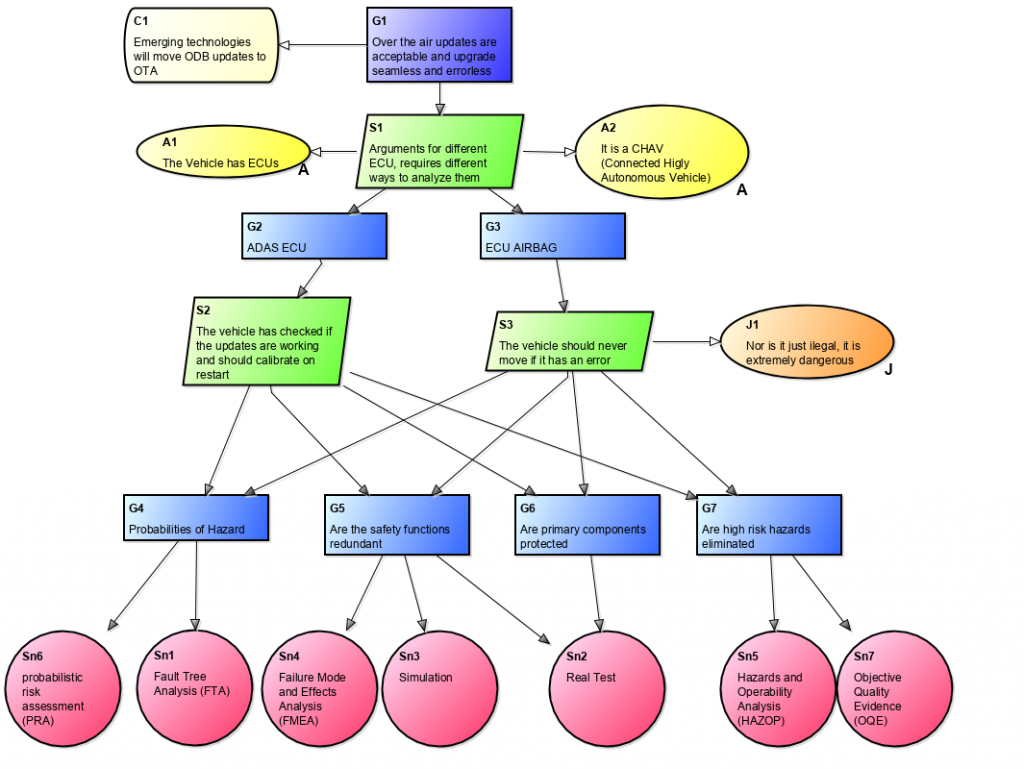Building a safety case does not have to be a hassle.
Let’s start by getting to the point, of what is a safety case. A safety case is a written proof that identifies the hazards and risks of a manufactured product or installation. A safety case is a structured argument, supported by evidence, intended to justify that a system is acceptably safe, and when there is danger or damage to make it as low as reasonably possible (ALARP). In industries like transportation and medicine, safety cases are mandatory and legally binding. Safety cases tend to be presented in a document of textual information and requirements accompanied by a graphical notation. The most popular way to this graphical notation is using the Goal Structure Notation (GSN). Even though a requirement in the automotive ISO 26262, the GSN notation is not some farfetched complex. It is basically sets the goals, the strategies justifying the claims and evidence, and a solution to make that goal safe.
The elements of the Goal Structured Notation have a Symbol plus a count, and are inside a shape. They are as following: (*N represents a number that grows to N+1 on each preceding)
- A goal G(N), are rectangles, setting up and objective or sub objective of the safety case.
- A strategy S(N), represented in a parallelogram, describes process or inference between a goal and its supporting goal(s) and solutions.
- A solution Sn(N) shown inside a circle, demonstrates a reference or proof.
- A context C(N), shown like a square with curved edges. It defines the limits that apply to the outlined structure.
- A justification J(N), rendered as an oval shows a rational or logical statement
- An assumption A(N), also rendered as an oval, presents an intentionally unsubstantiated statement.
(Check: http://www.goalstructuringnotation.info/documents/GSN_Standard.pdf for more info)

So, considering how a safety case in the GSN notation is structured any program that can make sketches like Microsoft Visio or mind map could work. But there is a tool specifically for this it is called ASTHA-GSN. It has an student license, and the tool has some major pluses:
- A simple easy to use user interface
- It will track the number of structures you have placed and sequentially number them. Your first goal will automatically be G1, and then G2 and so on
- It follows the structure, and knowing you are building a GSN safety case it will tell you if what you are connecting is incorrect.
- It lets you color scheme
- All Goals as Blue
- Strategies as Green
- Solutions as red
- Contexts are yellow
- And justifications and Arguments are white and grey
In the pictures you can see a example of each structure and a practical example.


About the Author: Luis Pedro Cobos
 Luis Pedro is a Spanish researcher, he graduated as biomedical engineer at the UPC in Spain; and proceeded with a master’s degree in risk management and biomechanics. Furthermore, he also has a master’s degree in project management. He has worked for Volkswagen Group and SEAT in research and development of vehicle safety (both Active and Passive). His interest in the ever-evolving automotive industry and safety, plus the fact that as a biomedical and biomechanical engineer, the protection of human beings and minimizing the injuries in any accident is a must, he drove back to academia and into this PhD.
Luis Pedro is a Spanish researcher, he graduated as biomedical engineer at the UPC in Spain; and proceeded with a master’s degree in risk management and biomechanics. Furthermore, he also has a master’s degree in project management. He has worked for Volkswagen Group and SEAT in research and development of vehicle safety (both Active and Passive). His interest in the ever-evolving automotive industry and safety, plus the fact that as a biomedical and biomechanical engineer, the protection of human beings and minimizing the injuries in any accident is a must, he drove back to academia and into this PhD.


